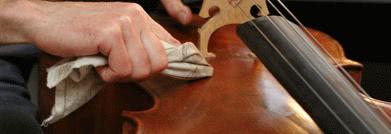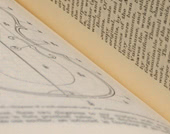Guide for Violin Care & Maintenance
Instrument Care and Maintenance by the Player
Temperature & Humidity
In most parts of North America, temperature and humidity levels vary dramatically from summer to winter. Stringed instruments are made principally of wood, which expands in the humid summer months and contracts in the winter. Expansion and contraction can cause minor inconveniences such as buzzing or open seams or major problems such as cracks. You can minimize humidity related problems by doing the following:
- Humidify your home during the dry winter months. Ideal humidity for instruments is 30-40% in most areas. Most homes require supplementary humidification from a cool mist, steam humidifier, or evaporative wick humidifier.
- Maintain a relatively constant humidity year-round. Dehumidification or A/C helps in the summer.
- Use an instrument or case humidifier when humidity drops below the normal range. These can be purchased at your violin shop.
- Do not subject your instrument to extreme temperatures. Never leave your instrument in your car.
Pegs
Stiff or slipping pegs are common problems. The three main reasons behind peg problems are:
- Seasonal humidity variations
- Improperly wound strings
- Poor peg fit
Slipping pegs are common during the winter because pegs shrink when conditions are dry. In most cases, rewinding a string in the optimal manner (see: Strings section) is all that is required. If pegs continue to slip or turn unevenly poor peg fit is likely the cause. A qualified technician can refit the pegs and solve the problem. Stiff pegs are often caused by expansion due to high humidity or a lack of peg lubricant. Lubricating the peg and/or re-positioning the peg further from the peg box wall will help.
Cleaning
Regularly wipe excess rosin dust away from the body and strings of your instrument with a dry cloth. Rosin build-up can mar some varnishes and can make strings sound poor. If a bow is over-rosined, a grainy sound will result and rosin dust will be visible. It is not necessary to rosin your bow every time you play. For more extensive cleaning on the body of your instrument, use a mild violin polish available from your stringed instrument shop.
Strings
Replace your strings regularly to ensure your instrument always plays and sounds to its full potential. Strings gradually lose their warmth and brilliance even if an instrument is not played frequently. Active players change their strings as often as every six months for optimum sound and performance. Students should generally replace the strings on their instruments yearly. When changing strings, always replace them one at a time and make sure your bridge does not begin to lean forward or backwards. Most strings have a 'break-in' period of a few days before they settle, stay in tune and sound their very best.
To wind on a new string, maintain some tension on the string at all times. Overlap the string once before you continue to wrap it around the peg. Always take care to wind the string close to the pegbox on the same side as the peg you are adjusting. A gentle fit against the wall of the pegbox will prevent most pegs from slipping and strings from unwinding.
| Shop For Violin Strings |
Shop For Viola Strings |
Shop For Cello Strings |
Shop For Bass Strings |
Bridge
This carved, wooden support holds the strings at the correct height and distance from each other and transmits the sound energy from the strings to the body of the instrument. Every bridge should be precisely carved by a professional luthier and custom fit to the table of each instrument. Since the bridge is fragile and not glued or fixed to the table in any way, it is necessary to prevent impact to this sensitive area and to ensure the bridge remains straight and upright. Even with normal use and regular tuning, a bridge will gradually lean forward or back in the direction of the pegs or fine-tuners. If the bridge is left in this position it will eventually warp under string tension. A bridge that is slightly warped can be straightened at your violin shop but a severely warped bridge will need replacement. To extend the life of a bridge, regularly inspect its position and straighten it when necessary. To do this, one must grip the bridge firmly with both hands and carefully ease it back into an upright position. If you are not comfortable moving the bridge yourself, most teachers or any of our staff would be pleased to assist you.
Instrument Adjustment and Repair
*We recommend a that a qualified bowed or stringed-instrument repairer be consulted for the following repairs and adjustments:
Seams
Dry conditions can cause seams to open, which may generate unwanted buzzes or sounds. Open seams can be repaired without difficulty at your violin shop. Traditional violin maker's glue is used to close seams. Several hours or overnight drying time is required before instruments can be taken home. Other glues must never be used for any repairs on your instrument.
Cracks
Cracks should be repaired immediately so that they do not lengthen or collect dirt. In most cases quickly repaired cracks are stable and virtually invisible. Serious cracks may require special attention and techniques that use interior cleats or patches.
Soundpost
The fit of your soundpost inside your instrument is crucial for good sound production. Each post is custom cut to fit precisely in a specific position. A poorly fit soundpost can impede the transference of sound energy and can even damage the table or back of your instrument.
Bridge
The bridge must be custom carved to fit the table of each instrument. The process of carving a bridge takes knowledge, experience, skill and time. The fit, like that of the soundpost, is very important to the sound quality of the instrument and requires precise cutting and thicknessing. The final touches on a bridge are aesthetic and unique to each maker, similar to that of a handwritten signature.
Fingerboard
Although ebony is very dense wood, your fingerboard will eventually show signs of wear from playing. Grooves may develop from string friction or small bumps may appear near the finger positions. These fingerboard irregularities can be eliminated by planing ('dressing') the board. Occasionally, very worn or warped fingerboards need to be replaced. Having a new fingerboard installed on your instrument will not affect its value but it can improve intonation and playability.
Bow Maintenance and Repair
The Stick
It is very important to always loosen the hair on your bow after each and every use. Otherwise, a bow left at tension over time is prone to warp and lose camber (the vertical curve of the stick). Regular use from playing may also affect the shape and playability of a stick. Should a bow require straightening or cambering, a qualified repairer can restore a bow to optimum playing condition with the careful use of heat, knowledge and skill.
The Hair
Bows require regular rehairing with good quality, unbleached horse hair. Hair stretches and wears with use, becoming brittle with age. Active string players require frequent bow rehairing, typically every three to six months, to maintain the best quality of sound and responsiveness. Student bows may be rehaired less frequently, depending on usage. Bring your bow to a qualified bow specialist for rehair. If the hair stretches a lot, the screw may eventually cease to tighten. If you encounter serious resistance when tightening the bow, do not force the screw any further. Continuing to tighten the screw could crack the stick. Since hair shrinks in dry conditions and lengthens in humid environments, rehairing must be done with local climates in mind. Lastly, avoid touching the hair so it does not become soiled and ineffective.
The Eyelet
Inside the frog of your bow is a small metal part called the eyelet. The bow screw travels through the eyelet which has the dual function of partnering with the screw to tighten the bow and securing the frog firmly to the stick. Over time the threads on the eyelet may become worn. If your screw will not tighten, the eyelet may need replacement. A repairer can find the correct sized eyelet for your bow (eyelet sizes vary) and install it for you.
The Tip
The most fragile part of a bow is the tip. The ivory, silver or high-grade plastic tip face that lines the head is not merely ornamental but serves to protect the tip during normal use and during the process of rehair. If the ivory tip face ever develops tiny cracks, it should be replaced by a qualified bow maker or restorer.
You can also download the guide:
- Guide for Violin Care & Maintenance (95 KB PDF)
Get Adobe Reader
In order to view PDF documents, you will need the Adobe Reader. Vist www.adobe.com to download it.
Frequently Asked Questions
If I take my instrument on a plane, what preparation does it require?
Violins/Violas: Take your violin or viola onboard and stow it in an overhead compartment. Aircraft cabins do have lower humidity in flight than normal good conditions but the risks are not high. Minimize humidity-related risks by moistening your case/instrument humidifier prior to the your flight. Your instrument requires no further adjustment to ensure its safe transport. Some airlines are refusing to accept violin cases as hand luggage due to their length. However, such refusals are rare at this point.
Cellos/Basses: Cellos are difficult and/or costly to take onboard so most cellists are obliged to check their instruments in the cargo hold. Use a heavy duty fibreglass or carbon fibre case if at all possible. Removing the bridge, strings and tailpiece and lowering the soundpost is the safest option for long trips (especially those involving connecting flights). This may not be possible if you do not have a violin maker/repairer available to help you reassemble the setup. If you do not remove the above parts be sure you fill the area around the bridge and under the tailpiece with foam to prevent moving during transport.
Should I have my instrument's soundpost adjusted?
While moving the soundpost can affect the sound quality and volume your instrument produces, other aspects of stringed instrument construction also contribute to the overall sound. Wood grade, strings, varnish, quality of workmanship and the thicknesses of the instrument's sides, table and back are among the many factors that affect an instrument's tone. If you are not satisfied with the sound your instrument is producing or suspect your soundpost is poorly fitted or incorrectly positioned, we can move, adjust or replace the post if necessary to achieve the best sound possible. We can also consider all other factors that may be causing disatisfaction. Please book an appointment for this service.
How can I get more information on stringed instrument care and maintenance?
The books, Commonsense Instrument Care by James McKean and The Violin Owner's Manual (from Backstage Books) are useful and informative resources for any string player or ask us!





